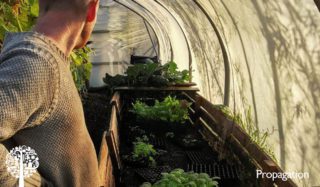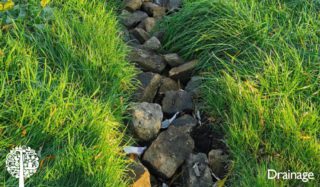Garden Culture Magazine |
The conversation around environmental control in urban farming is constant, but ‘old school’ soil growers tend not to engage in the topic as much. Growers worldwide cultivate a wide range of types of land in their gardens, allotments, smallholdings or farms, be it private or for profit. Ideally, these will be easy to access, with water and some shelter. However, some of us grow in the most challenging climates and have to make the most of the resources, like water-saving techniques in hot deserts and maximizing sunlight in arctic gardens. For growers on the green British Isles, one dominant element springs to mind: Rain — a hell of a lot of it.
Rain, Rain, Go Away
When it comes to the topic of rain, the British certainly have a few things to say. When I moved here over a decade ago, people always told me to carry sunglasses and a brolly (that’s an umbrella, if you are unfamiliar with this term) in my bag. When I complain about the miserable Yorkshire rain that comes in at you sideways and infiltrates scarves like an icy ninja, my husband tells me, “if you don’t like the weather in Yorkshire, wait five minutes.” He is usually right – the sun never hides for long in the world’s most temperate climate.
These two lines came to mind while driving to a unique market garden right in the middle of the soggy moor. The October rain was lashing viciously despite the absence of any scary-looking clouds; a second later, the most beautiful double rainbow appeared, and I had to stop the car and admire the glowing arc of joy. I was slightly late for my visit, but the contrast between the downpour and the rainbow highlighted the rawness and unpredictability the weather serves us up here.
Gimme Shelter
The garden I was visiting is unique in many ways, and water plays a significant part in its existence. Long Causeway Market Garden is a nerve-wracking exposed piece of land. It may be ‘only’ 320 meters above sea level, but being right at the edge of the Pennine moor between Yorkshire and Lancashire, there’s no shelter from the elements. Strong winds, plenty of rain and scorching summer heat make it difficult for a grower to supply the locals with fresh produce. However, for Will Johnson, working on such rugged land is a fact of life and chatting with him brought a picture of a humble man with true resilience.
A Love For Gardening
Will’s growing adventure started with an apprenticeship near the Swedish student town of Uppsala, where he worked with an organic veg grower for a year. He began with a WWOOFing experience (World Wide Opportunities on Organic Farms) in Europe before working with an organic veg grower at Coleshill National Trust Estate in Oxfordshire. He went on to manage a Community Supported Agriculture project in Leamington Spa.
Will’s resume paints a picture of a keen learner and a passionate grower. In September 2017, his travels brought him to Yorkshire, where he met Hywel, the owner of the garden’s land. Based on a mutual approach to land management, they agreed that this is the place for Will’s market garden. In his eyes, all land comes with its challenges, but the main thing that made it possible was trust and cooperation between the pair.
Water Diversion
With the land being rather wet, covered in grass and rushes in most places, the work on the garden began with digging a series of drains to get rid of some groundwater. A mini digger dug a 250-meter culvert through the site, with two side ‘ribs’ forking out to the left and right, all filled with stones to take the excess water. Will describes his time during this period as ‘efficiently divided’ – he worked four days in a warehouse to earn a living and spent his four days off’ shaping the garden. His definition of ‘efficient’ sounds closer to most people’s definition of ‘exhausting’ if you ask me, but it seems to have worked out well.
All this work allowed the main garden area to be dry enough to plant crops. Now, Will has three polytunnels neatly planted with winter salads featuring crunchy leaves of claytonia, mustard frills and chard. The outdoor garden area has stunning purple cabbages, winter leeks, parsnips and winter leaves, right next to beds planted with courgettes and squash in the summer. Last year, the average weight of the squash was just over a kilo each. This summer’s yield has increased almost threefold, with 200 squashes weighing over 500 kilograms. Managing the land in a permaculture style, building up soil layers, and growing organically is paying off as the garden’s delicious produce is distributed to the nearby market towns. And the demand isn’t slowing down.
Gentle, Natural Irrigation
As we walked through the garden, I saw one of the polytunnels being watered through a low-pressure standpipe. Flowing at around 25 liters per minute, the stream from up the hill gently irrigates the crops. Initially diverted this way 500 years ago, it used to supply water to a house down the mountain but now is primarily used to irrigate the garden. We hiked to the point where the water entered the pipe. While I hadn’t expected much in the way of sophisticated pump mechanisms, I still smiled to discover a genuinely homespun contraption consisting of a plastic crate, a metal bottle with holes drilled in it, and a sock. Simple solutions are often the most effective, though, and Will proudly reports that it has never been blocked with any silt or debris and flows perfectly through its labyrinth of pipes to the irrigation system in the polytunnel.
Living Soil
As a believer in goodness coming from quality soil, Will’s composting operation is already producing black gold used to mulch the beds. However, his plan for this winter is to improve the vehicle access to increase the composting capacity by taking woodchip deliveries. Realistically, there will still be the need to buy some mulch, but the more he produces on-site, the better for the environment and the pocket, not to mention his learning process.
Profits
I wondered how profitable and manageable running a garden on top of the moor could be. There are no neat gravel paths but a lot of grass no further than ten meters from the veg beds, representing a real slug control challenge. Also, with a constant trickling of water a few meters away, the ground is always moist enough to give slugs a chance. Ever-positive, though, Will says neither he nor the customers mind the odd hole in their salad. After all, with everything being organically grown, we can’t blame the slugs for having a go.
In his third year of growing, Will works the garden full time and can make a living out of it for one person. In his growing plan, he considers the needs of the land and the potential profit. If Will concentrates his time on growing only salad leaves, his earnings will be higher. But by having a variety of crops from root veg and summer squashes to sweet tomatoes, he provides a variety of flowers for the pollinators and increases biodiversity in the area. With the help of his dad during the summer months, he steadily tends the land, slowly shaping it to be a truly unique space.
Resilience At Its Best
Moors always made me think of resilience. The trees that grow here are hard as nails, and the wildlife stands through the harshest conditions. And amongst this rawness, this beautiful island of resilience stands, changing the land respectfully and with great purpose.












